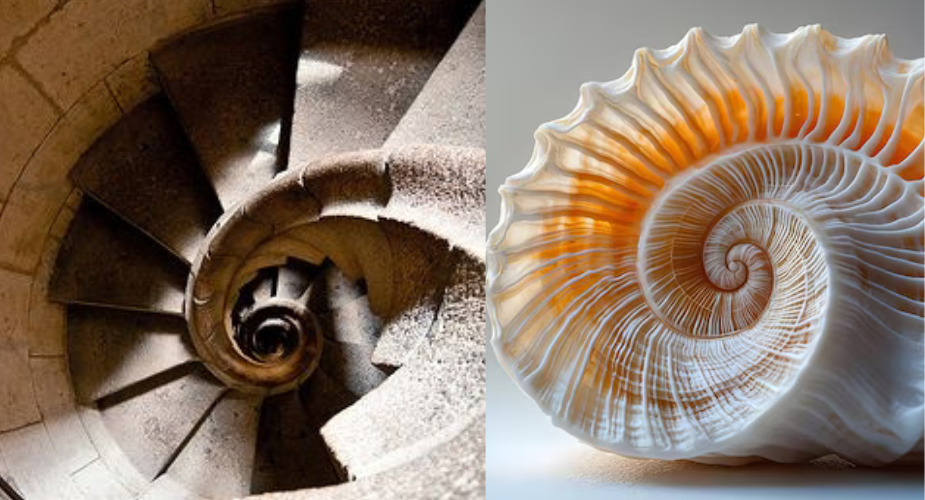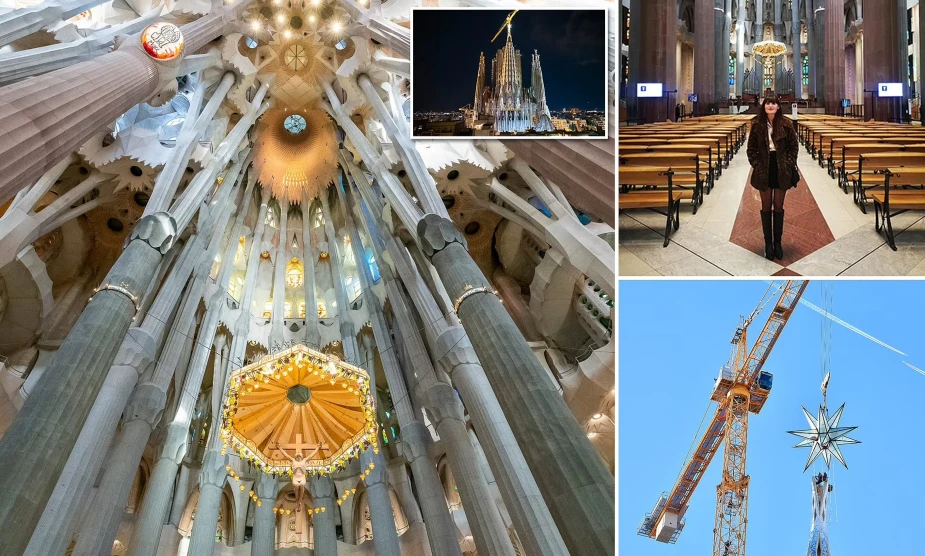The Sagrada Familia in Barcelona features spiral staircases inside the towers, allowing visitors to climb to the upper galleries and enjoy a beautiful city view. The staircases are known for their unique and dramatic design, which shows architect Antoni Gaudí’s interest in math. They look like a Fibonacci spiral, using the Fibonacci sequence. The staircases are part of the basilica’s construction, which has been underway since 1882 and is expected to be completed in 2026.
Vacatis Tip! You will need a Sagrada Familia Entry Ticket to explore the staircase. You can also choose the Tower Access Ticket for a more comprehensive experience.
Symbolism and Inspiration

Gaudí’s work is deeply infused with Christian symbolism and his profound reverence for nature. The staircases are no exception; they are imbued with meanings that transcend their physical form. The ascending spiral can be seen as a metaphor for spiritual elevation and the journey of faith, reflecting Gaudí’s intent to lead the observer’s mind and spirit toward the divine. The Fibonacci spiral, found in shells, sunflowers, and other natural phenomena, symbolizes the interconnectedness of all living things.
This serves as a reminder of humanity’s place within the natural world. By using natural motifs in his design, Gaudí conveys his belief in God as the ultimate architect, with nature as his creation. This harmonious blend of spirituality and natural inspiration permeates every aspect of the staircase.
Visitor Experience
| Aspect | Experience |
|---|---|
| Awe & Wonder | The panoramic views of Barcelona from the towers are breathtaking! You can see all the way to the sea and even make out some famous landmarks. |
| Photography | Get a fast-track entry ticket and capture the unique beauty of the staircases and the views they offer before the crowds. |
| Physical Challenge | There are a lot of narrow, winding stairs, so be prepared for a bit of a workout. |
| Spiritual connection | For some visitors, climbing the towers can be a spiritual experience. |
Is it Dangerous?
The Sagrada Familia’s staircases offer stunning views, but they also have unique features to consider for safety:
- No handrails: The staircases have no interior walls and handrails to hold onto. Those who fear heights or need extra support may want to reconsider.
- Narrow steps: The staircase has 504 narrow steps, and visitors must walk down to exit the tower. Elevators take you to the top, but the only way down is by a long, narrow set of curving stairs.
- Limited access: Children under 6 and those with heart conditions, claustrophobia, or mobility limitations should avoid using the staircases.
Controversies
The Sagrada Familia staircase plan for the entrance has been a subject of ongoing disputes and construction controversies. The basilica’s Board of Construction has proposed a 60-meter-long stairway that would lead from the Glory façade to Aragó Street. It requires the demolition of several buildings and potential eviction of up to 3,000 people.
This stairway has been a contention between the basilica and residents, with some arguing that it was not part of Antoni Gaudí’s original designs. The final decision regarding the construction of this stairway remains with the Barcelona City Council.
Proposed Staircase Protest

Despite protests from locals, the Roman Catholic charity overseeing the church’s construction, Junta Constructora del Temple Expiatori de la Sagrada Familia, is determined to move forward with these plans. The Association for Persons Affected by the Sagrada Familia is an organization that is suing to halt the staircase’s construction, and Salvador Barroso represents them.
When the Spanish Civil War broke out in 1936, anarchists destroyed many of Gaudi’s original designs. Barroso argues that Gaudi never intended for the staircase to exist and that architects subsequently created it in an attempt to realize his vision.
Sagrada Familia Staircase Today
Sagrada Familia is still under construction, and the stairway project must be completed. The basilica’s construction has been ongoing since 1882 and is currently scheduled to be completed in 2026. Once completed, the stairway would provide a direct entrance to the basilica’s main door, which is currently located on the first floor. You can visit the rest of the basilica and see the spiral stairway inside the basilica by buying a ticket.
Planning a trip to Sagrada Familia? We have got you covered! Plan a smooth trip with our comprehensive guides:
• Sagrada Familia Hours
• Sagrada Familia Dress Code
• Sagrada Familia Nativity Facade
FAQs
1. What is the significance of the Sagrada Familia staircase?
The stairway inside Sagrada is not just a functional element but also an architectural masterpiece designed by Gaudí. It reflects Gaudí’s unique approach to combining functionality with intricate design, symbolizing the connection between earth and heaven.
2. How many stairways are there in the Sagrada Familia?
The basilica features nine stairways, each with its own design and purpose. The most famous are the spiral stairways within the towers, which are 504 steps in length.
3. Can I climb the stairways?
Yes, you can climb some of the stairways to reach various points of the towers. However, access might be restricted to certain staircases for safety or preservation reasons.
4. What is the design inspiration behind the staircases?
Gaudí drew inspiration from natural forms for the design of staircases. The spiral shape of the staircases mimics the shells of certain mollusks, showcasing Gaudí’s fascination with nature.
5. Was the entrance staircase in the Sagrada Familia the original design of Gaudí?
The controversial entry staircase of the basilica is believed by some to not be a part of Gaudi’s original design. However, the board that manages the church says it was.
Featured Image: Facebook.com(BasilicadelaSagradaFamilia)




